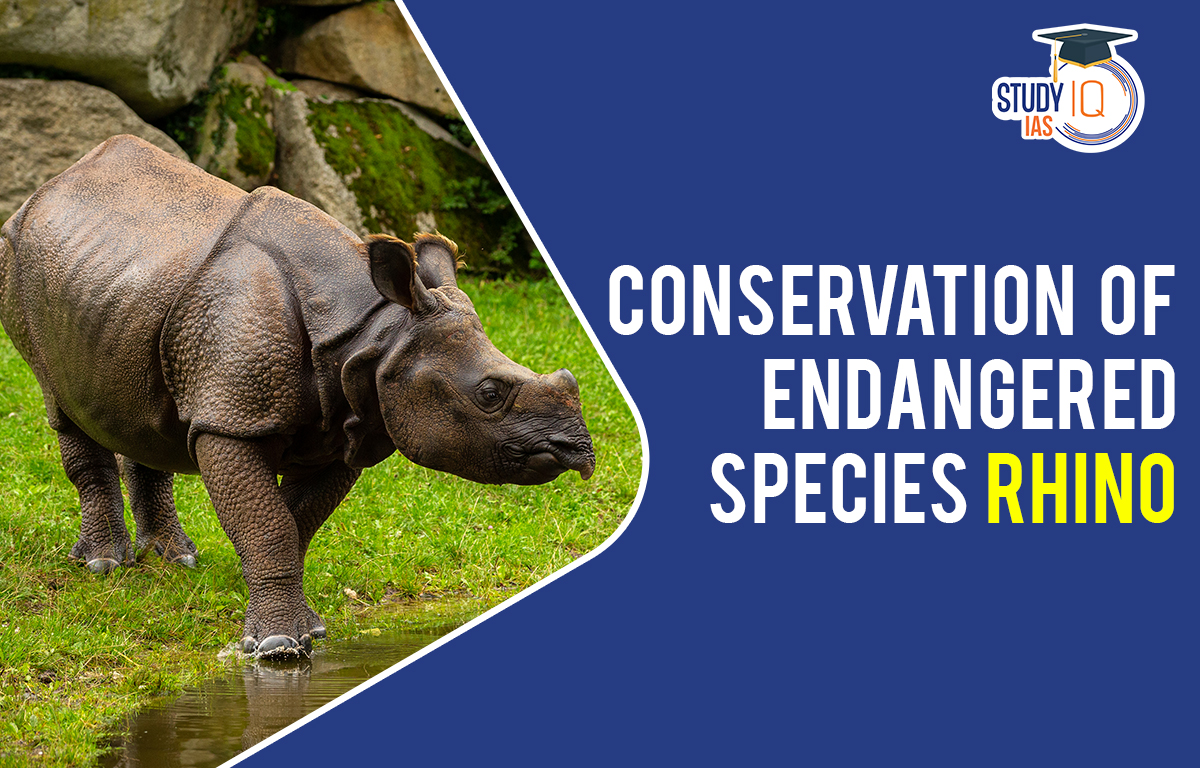Table of Contents
About Indian Rhinoceros

- Range: The Indian Rhinoceros (Greater one-horned rhino) can only be found in the Brahmaputra valley, parts of North Bengal, and parts of southern Nepal.
- Characteristics: It has a single black horn that can grow up to 60 cm, and a tough, grey-brown hide with skin folds, which gives the animal its characteristic look.
- Rhinos in the wild: There are around 3,700 Indian rhinos in the wild today.
- Kaziranga National Park (KNP) of Assam alone has 2,613 animals.
- There are more than 250 other rhinos in the Orang, Pobitora, and Manas parks of Assam.
- Protection Status:
- The Indian Rhino is listed as vulnerable in the IUCN Red List.
- It is listed in Appendix 1 of the CITES
- Protected under Schedule I of the Wildlife Protection Act, 1972

- Threats:
- Poaching: Rhinos are hunted for their horn, which is used in traditional Chinese medicine to cure ailments such as cancer and is also an aphrodisiac.
- Fragmentation of habitat: The construction of roads and railways has fragmented protected areas. This prevents rhinos from carrying out their annual migration.
- Floods and wildfires: Rhinos inhabit low-lying grasslands of India. These grasslands are vulnerable to wildfires and annual flooding.
- Invasive plants: Many invasive grass species have spread across Rhino habitats. These plants out-compete the native plants on which Rhinos rely for food.
- Higher population density: High population density leads to lower breeding rates. This affects the genetic diversity of Rhinos in the long run.
Assam Government’s Efforts to Protect Indian Rhino
- Rhino Protection Force: The government of Assam has set up a Special Rhino Protection Force to keep a check on rhino poaching and related activities at Kaziranga National Park (KNP).
- Burning rhino horns: In order to bust myths about rhino horns, the Assam authorities publicly burnt almost 2,500 rhino horns. This sent a clear message to poachers and smugglers that such items have no value.
- Landscape restoration: Developing new areas into Rhino habitats and connecting them with existing protected areas. This will help in increasing Rhino numbers.
- Awareness creation: Local communities are being made stakeholders in Rhino protection. They will act as eyes and ears of the forest department.
- Strengthening law enforcement: Laws related to wildlife trade have been strengthened in order to curb illegal trade of Rhino horns.
Initiatives to Conserve Indian Rhinos
Indian Rhino Vision 2020:
- It was launched in 2005 to help the greater one-horned rhino reach a wild population of at least 3000 rhinos.
- It is a collaboration between International Rhino Foundation, Assam’s Forest Department, Bodoland Territorial Council, World Wide Fund.
- The goal of Indian Rhino Vision 2020 is to reduce risks to India’s rhino population by ensuring that the animals are spread throughout seven protected areas of Assam by the year 2020.
- Kaziranga, Pobitora, Orang National Park, Manas National Park, Laokhowa wildlife sanctuary, Burachapori wildlife sanctuary and Dibru Saikhowa wildlife sanctuary are the protected areas.
The New Delhi Declaration on Asian Rhinos 2019:
- The declaration was signed by Bhutan, Nepal, Indonesia and Malaysia to increase the population of three species of Asian rhinos, including Indian Rhinos.
- Steps to be taken:
- Undertaking studies on health issues of the rhinos, their potential diseases and taking necessary steps;
- Collaborating and strengthening wildlife forensics for investigation purposes;
- Strengthening transboundary collaboration among India, Bhutan and Nepal for the conservation and protection of the Greater one-horned rhino.


 UPPSC Previous Year Question Papers, Dow...
UPPSC Previous Year Question Papers, Dow...
 Most Commonly Used Cancer Drugs and Thei...
Most Commonly Used Cancer Drugs and Thei...
 Tansen Biography, Musical Legacy and Mas...
Tansen Biography, Musical Legacy and Mas...





















